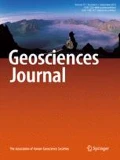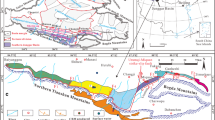Abstract
The geochemical information of produced water from coalbed methane (CBM) wells is abundant in geological significance. Based on the conventional ions, hydrogen and oxygen isotopes (δD and δ18O) and trace element tests of 27 produced water samples from CBM wells, the geochemical identification of the source and environment of produced water from CBM wells and its productivity significance have been analysed. The following conclusions have been drawn: CBM produced water can be divided into three categories, namely, polluted water from frac fluids, polluted surface water and formation water. The formation water has low Cl- concentration, low total dissolved solids (TDS) concentration, and light δD and δ18O. The water polluted by frac fluid has high Cl- and TDS concentrationt, and heavy δD and δ18O. The polluted surface water has high SO42- and light δD and δ18O. CBM groun dwate r environments can be divided into confined and unconfined systems. The confined system is characterized by low Na+/Cl- value, high (Cl- - Na+)/Mg2+ value, a general absence of SO42-, high Sr and Ba and low F. The unconfined system is characterized by high Na+/Cl- value, low (Cl- - Na+)/Mg2+ value, low SO42-, low Sr and Ba and high F. Constructing a cross plot with the new D drift index (d') value and Cl- concentration can further identify four types of source-water environments: an unconfined formation water system, an unconfined surface water system, a confined system heavily polluted by frac fluids, and a confined system only slightly polluted by frac fluids. The unconfined system often produces more formation water and has high CBM production. The confined system often produces water more heavily polluted by frac fluids and is low in CBM production. The fitting formulas of hydrochemical productivity have been established for daily CBM and water production of CBM wells.
Similar content being viewed by others
References
Brian, H. and Irving, F., 1969, Geochemistry and origin of formation waters in the western Canada sedimentary basin - I. stable isotopes of hydrogen and oxygen. Geochimica et Cosmochimica Acta, 33, 1321–1349.
Craig, H., 1961, Isotopic variation in meteoric waters. Science, 133, 1702–1703.
Dansgaard, W., 1964, Stable isotopes in precipitation. Tellus, 16, 436–468.
Guo, C., Qin, Y., Xia, Y.C., and Lu, L.L., 2017, Geochemical characteristics of produced water from CBM wells and implications for commingling CBM production: a case study of the Bide-Santang Basin, western Guizhou, China. Journal of Petroleum Science & Engineering, 159, 666–678.
Huang, H.Z., Sang, S.X., Miao, Y., Dong, Z.T., and Zhang, H.J., 2017a, Trends of ionic concentration variations in water coproduced with coalbed methane in the Tiefa Basin. International Journal of Coal Geology, 182, 32–41.
Huang, H.Z., Bi, C.Q., Sang, S.X., Miao, Y., and Zhang, H.J., 2017b, Signature of coproduced water quality for coalbed methane development. Journal of Natural Gas Science & Engineering, 47, 34–46.
Lei, W. and Qin, S.F., 2012, Characteristics of trace elements and hydrogen and oxygen isotopes in the formation water of the Xujiahe formation, Sichuan basin. Acta Petrolei Sinica, 33, 56–63.
Li, W., Liu, J.M., and Chen, XH., 1994, Characteristics of oil field water in Turpan depression and its petroleum geological significance. Petroleum Exploration and Development, 12, 12–18.
Liu, J.M., 1982, The characteristics of underground water chemistry and its application in oil field hydrology exploration. Petroleum Exploration and Development, 6, 49–55.
Moore, T.A., 2012, Coalbed methane: a review. International Journal of Coal Geology, 101, 36–81.
Qin, Y., Zhang, Z., Bai, J.P., Liu, D.H., and Tian, Y.D., 2014, Source apportionment of produced-water and feasibility discrimination of commingling CBM production from wells in Southern Qinshui Basin. Journal of China Coal Society, 39, 1892–1898.
Qin, Y., Moore, T.A., Shen, J., Yang, Z.B., Shen, Y.L., and Wang, G., 2018, Resources and geology of coalbed methane in China: a review. International Geology Review, 60, 777–812.
Rice, C., Flores, R., Stricker, G., and Ellis, M., 2008, Chemical and stable isotopic evidence for water/rock interaction and biogenic origin of coalb ed met hane, Fort Union Formation, Powder River Basin, Wyoming and Montana U.S.A. International Journal of Coal Geology, 76, 76–85.
Snyder, G., Riese, W., Franks, S., Eehn, U., Pelzmann, W., Gorody, A., and Moran, J., 2003, Origin and history of waters associated with coalbed methane: 129I, 36Cl, and stable isotope results from the Fruitland Formation, CO and NM. Geochimica et Cosmochimica Acta, 67, 4529–4544.
Strategy Research Center of Oil and Gas Resources Department, Ministry of Land and Resources, 2006, Assessment of Coalbed. China Land Press, Beijing, 300 p.
Taulis, M. and Milke, M., 2013, Chemical variability of groundwater samples collected from a coal seam gas exploration well, Maramarua, New Zealand. Water Research, 47, 1021–1034.
Tian, W.G., Shao, L.Y., Sun, B., Zhao, S.P., and Huo, W.G., 2014, Chemical behaviors of produced water from CBM wells in the Baode area Shanxi, China, and their control on gas accumulation. Natural Gas Industry, 8, 15–19.
Van Voast, W.A., 2003, Geochemical signature of formation waters associated with coalbed methane. American Association of Petroleum Geologists Bulletin, 87, 667–676.
Wang, B., Sun, F.J., Tang, D.Z., Zhao, Y., Song, Z.H., and Tao, Y., 2015, Hydrological control rule on coalbed methane enrichment and high yield in FZ block of Qinshui Basin. Fuel, 140, 568–577.
Wang, S.B., Tang, S.H., Wan, Y., Li, Z.C., and Zhang, S.H., 2013, The hydrogen and oxygen isotope characteristic of drainage water from Taiyuan coal reservoir. Journal of China Coal Society, 38, 448–454.
World Health Organisation, 1993, Guidelines for Drinking-water Quality (2nd edition), Volume 1. Recommendations. World Health Organisation, Geneva, 188 p.
Wu, C.C., Yang, Z.B., Qin, Y., Chen, J., Zhang, Z.G., and Li, Y.Y., 2018a, Characterisitics of hydrogen and oxygen isotopes in produced water and productivity response of coalbed methane wells in Western Guizhou. Energy Fuels, 32, 11203–11211.
Wu, C.C., Yang, Z.B., Qin, Y., Chen, J., Zhang, Z.G., and Luo, K.Y., 2018b, Geochemical comparison and its geological significance of CBM produced water in the Songhe and Zhijin blocks. Journal of China Coal Society, 43, 1058–1064. https://doi.org/10.13225/j.cnki.jccs.2017.1087
Yang, Z.B., Qin, Y., Yi, T.S, Zhang, Z.G., and Wu, C.C., 2019c, Analysis of multi-coalbed CBM development methods in western Guizhou, China. Geosciences Journal, 23, 315–325.
Yang, Z.B., Qin, Y., Wu, C.C., Qin, Z.H., Li, G., and Li, C.L., 2019b, Geochemical response of produced water in the CBM well group with multiple coal seams and its geological significance - a case study of Songhe well group in Western Guizhou. International Journal of Coal Geology, 207, 39–51.
Yang, Z.B., Zhang, Z.G., Qin, Y., Wu, C.C., Yi, T.S., Li, Y.Y., Tang, J., and Chen, J., 2018, Optimization methods of production layer combination for coalbed methane development in multi-coal seams. Petroleum Exploration and Development, 45, 312–320.
Yang, Z.B., Li, Y.Y., Qin, Y., Sun, H.S., Zhang, P., Zhang, Z.G., Wu, C.C., Li, C.L., and Chen, C.X., 2019a, Development unit division and favorable area evaluation for joint mining coalbed methane. Petroleum Exploration and Development, 46, 1–10.
Zhang, S.H., Tang, S.H., Li, Z.C., and Shi, W., 2016, Study of hydro-chemical characteristics of CBM co-produced water of the Shiz hu ang-nan Block in the southern Qinshui Basin, China, on its implication of CBM development. International Journal of Coal Geology, 159, 169–182.
Zhu, L., Fan, T., and Guo, H., 2014, Sources and stable isotope characteristics of precipitation in Southwest of China. Yunnan Geographic Environment Research, 26, 61–67.
Acknowledgments
Financial support for this work was provided by the National Natural Science Foundation of China (No. 41772155), the National Science and Technology Major Project of China (No. 2016ZX05044, No. 2016ZX05067), and the Fundamental Research Funds for the Central Universities of China (No. 2015XKZD07).
Author information
Authors and Affiliations
Corresponding author
Additional information
Publisher's Note Springer Nature remains neutral with regard to jurisdictional claims in published maps and institutional affiliations.
Rights and permissions
About this article
Cite this article
Yang, Z., Wu, C., Qin, Y. et al. Geochemical identification of the source and environment of produced water from CBM wells and its productivity significance: examples from typical CBM wells in eastern Yunnan and western Guizhou. Geosci J 24, 459–473 (2020). https://doi.org/10.1007/s12303-019-0032-9
Received:
Accepted:
Published:
Issue Date:
DOI: https://doi.org/10.1007/s12303-019-0032-9




